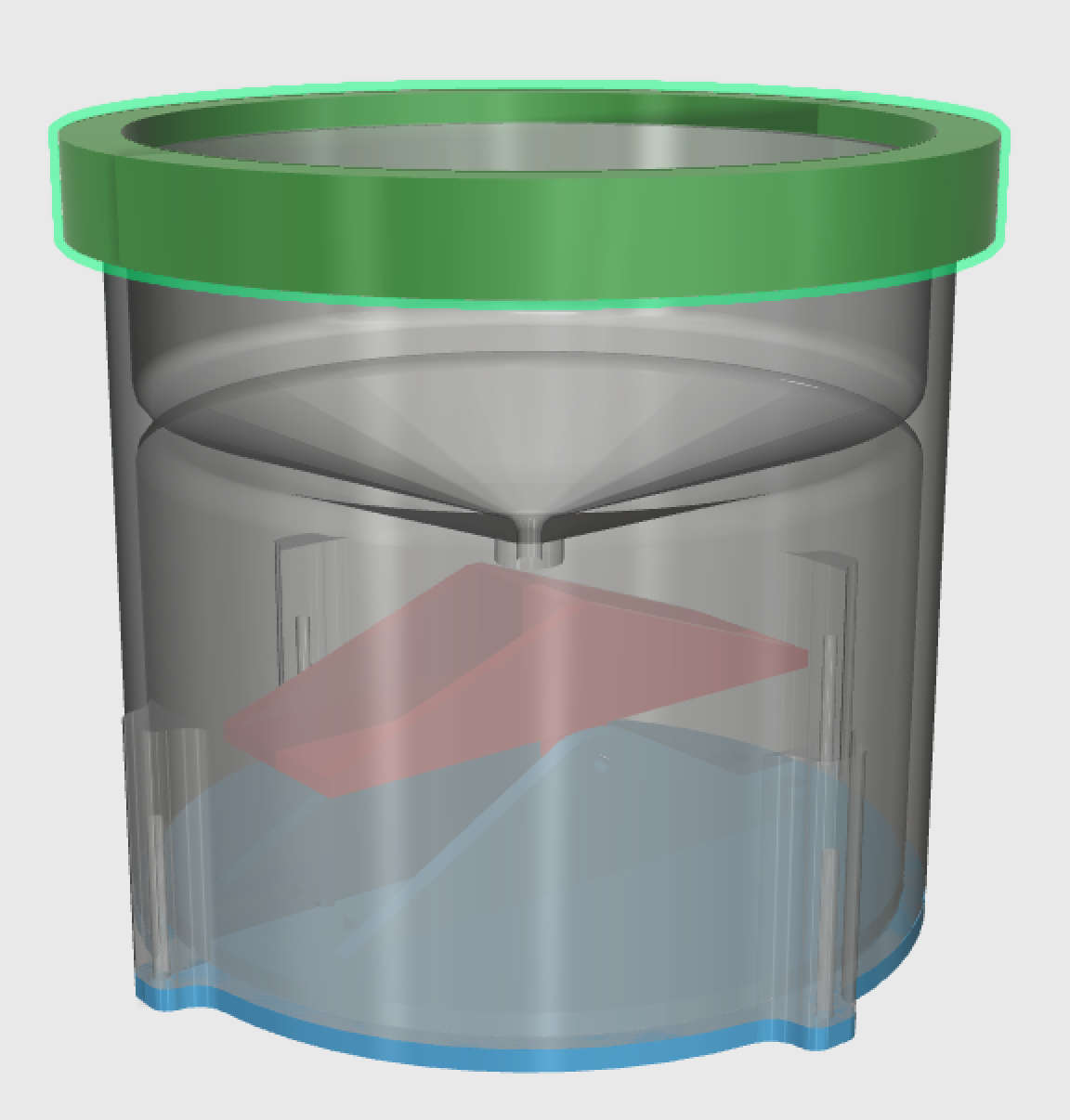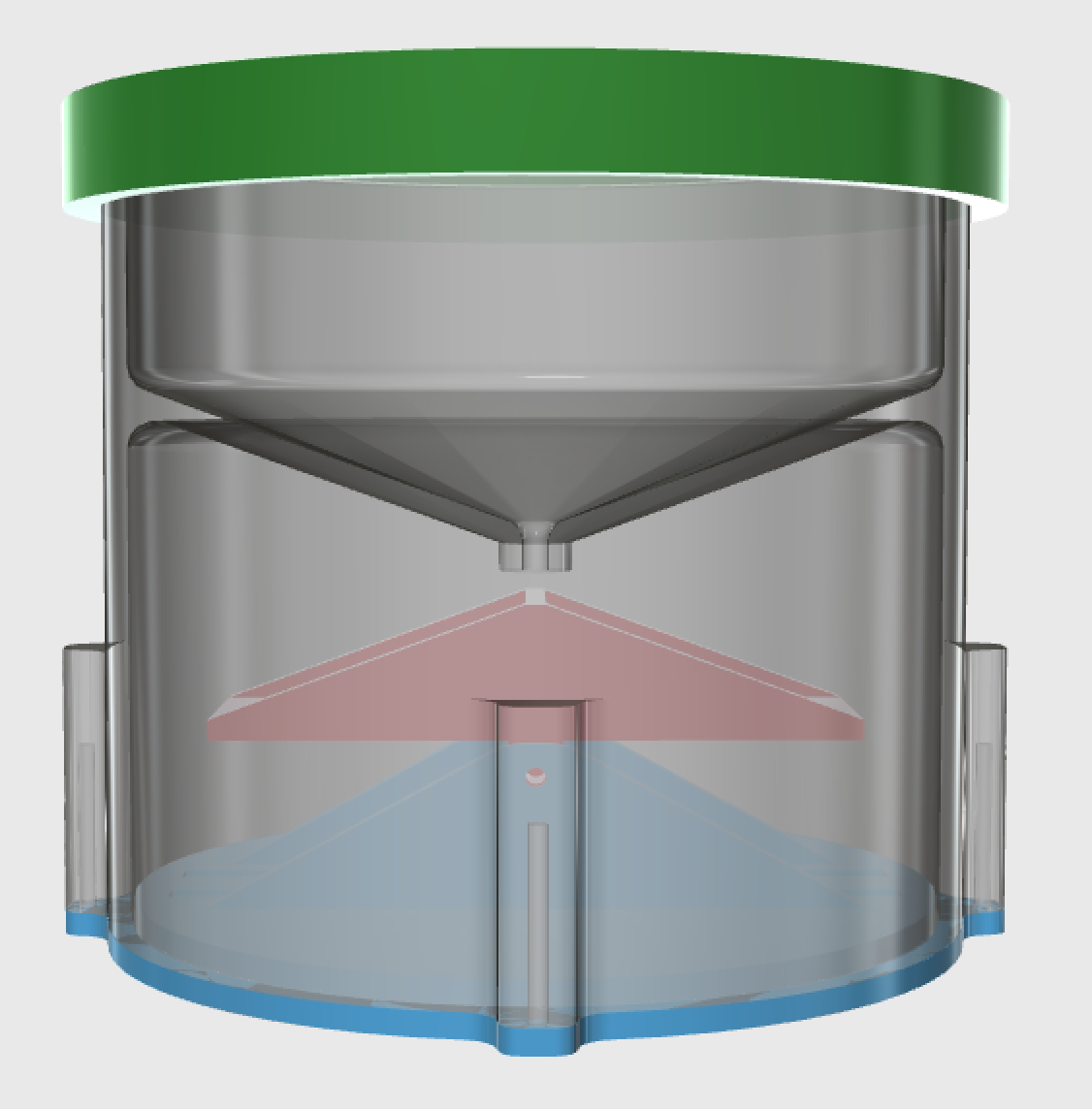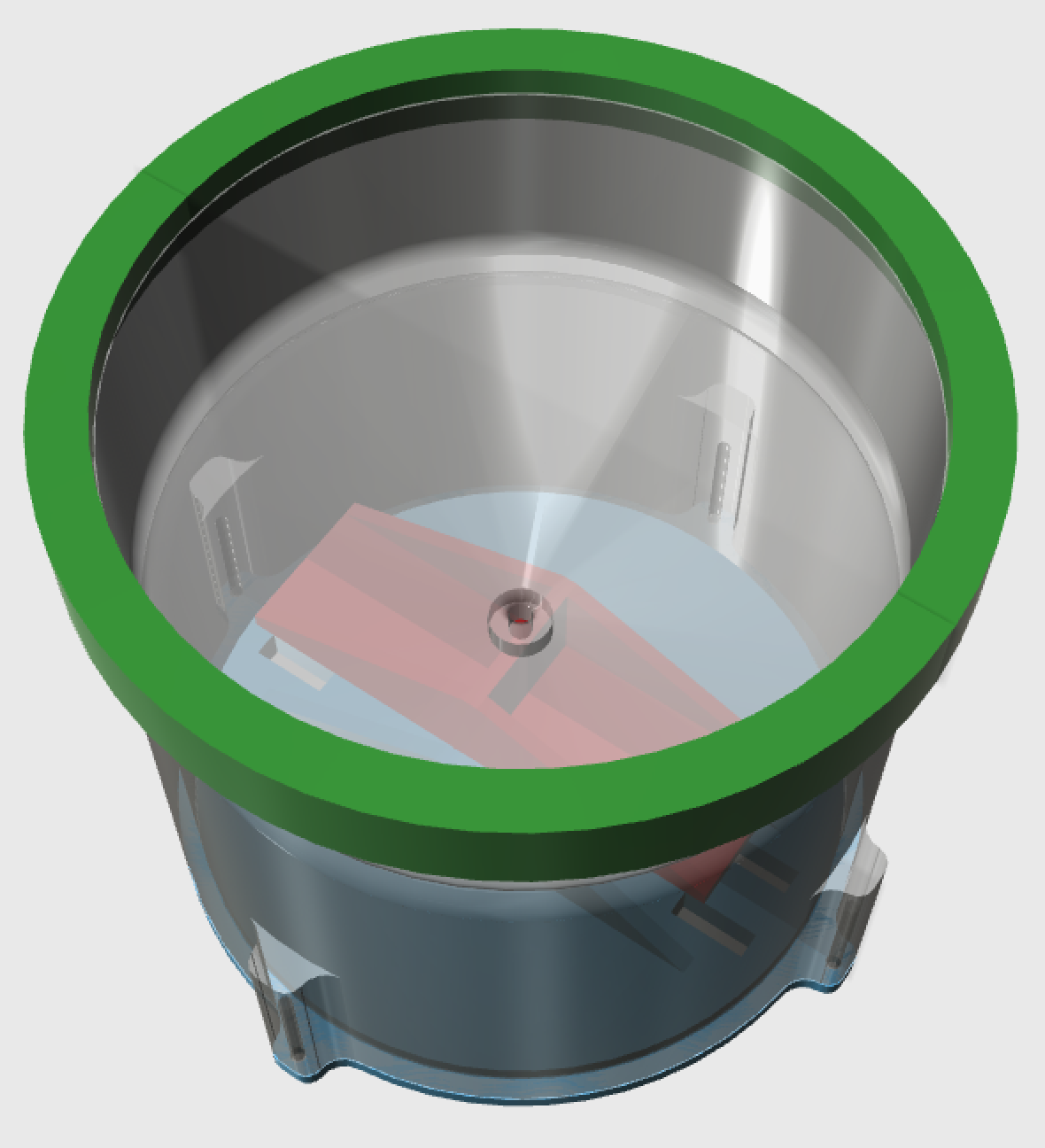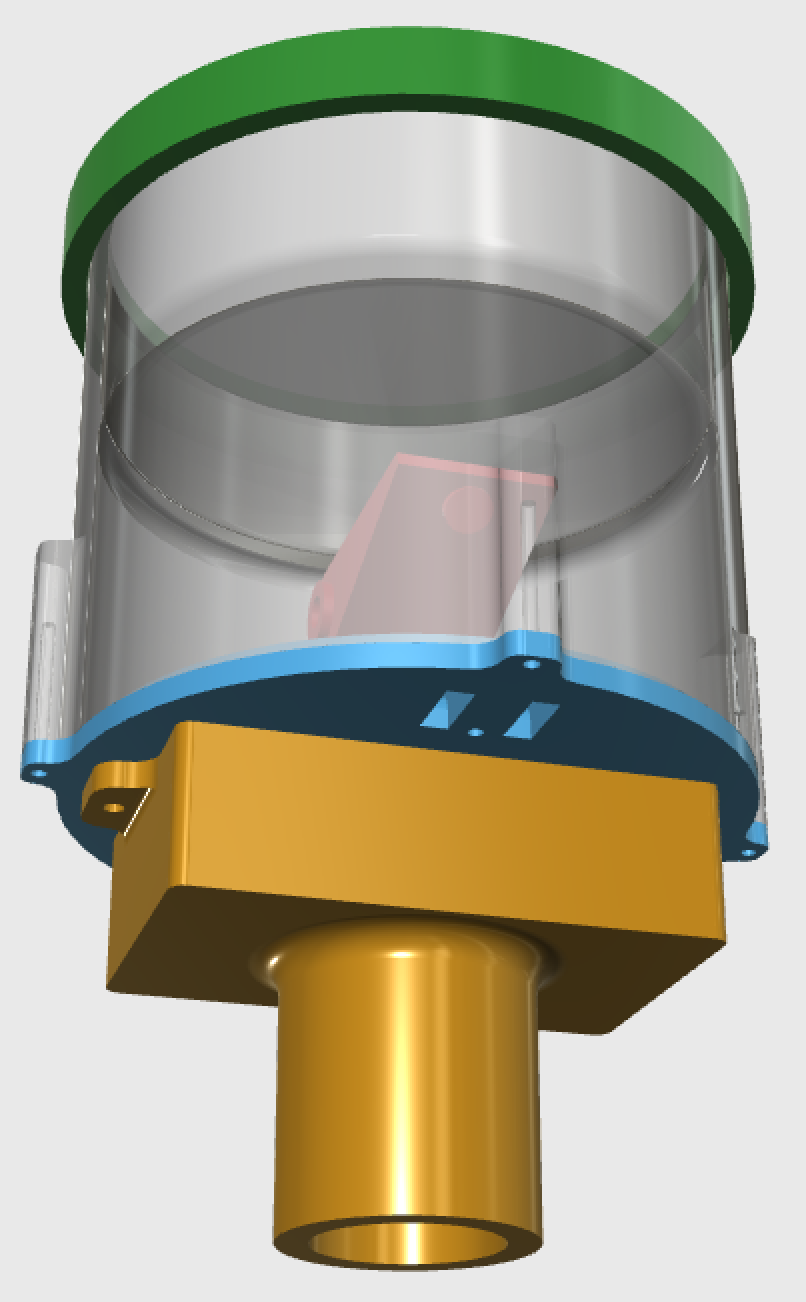Rain Guage
-
how about adding windspeed to the device?
-
how about adding windspeed to the device?
-
-
electronics box:
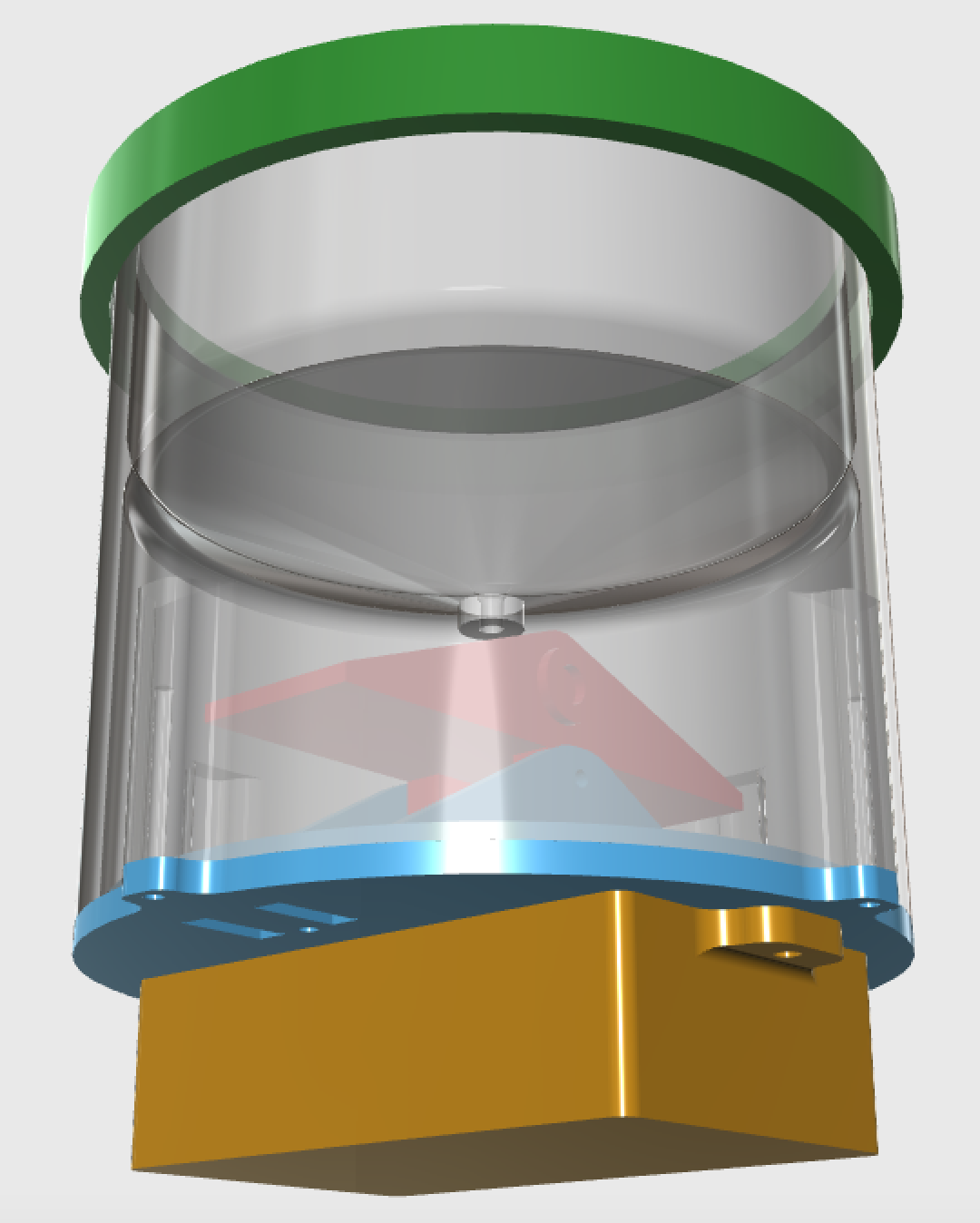
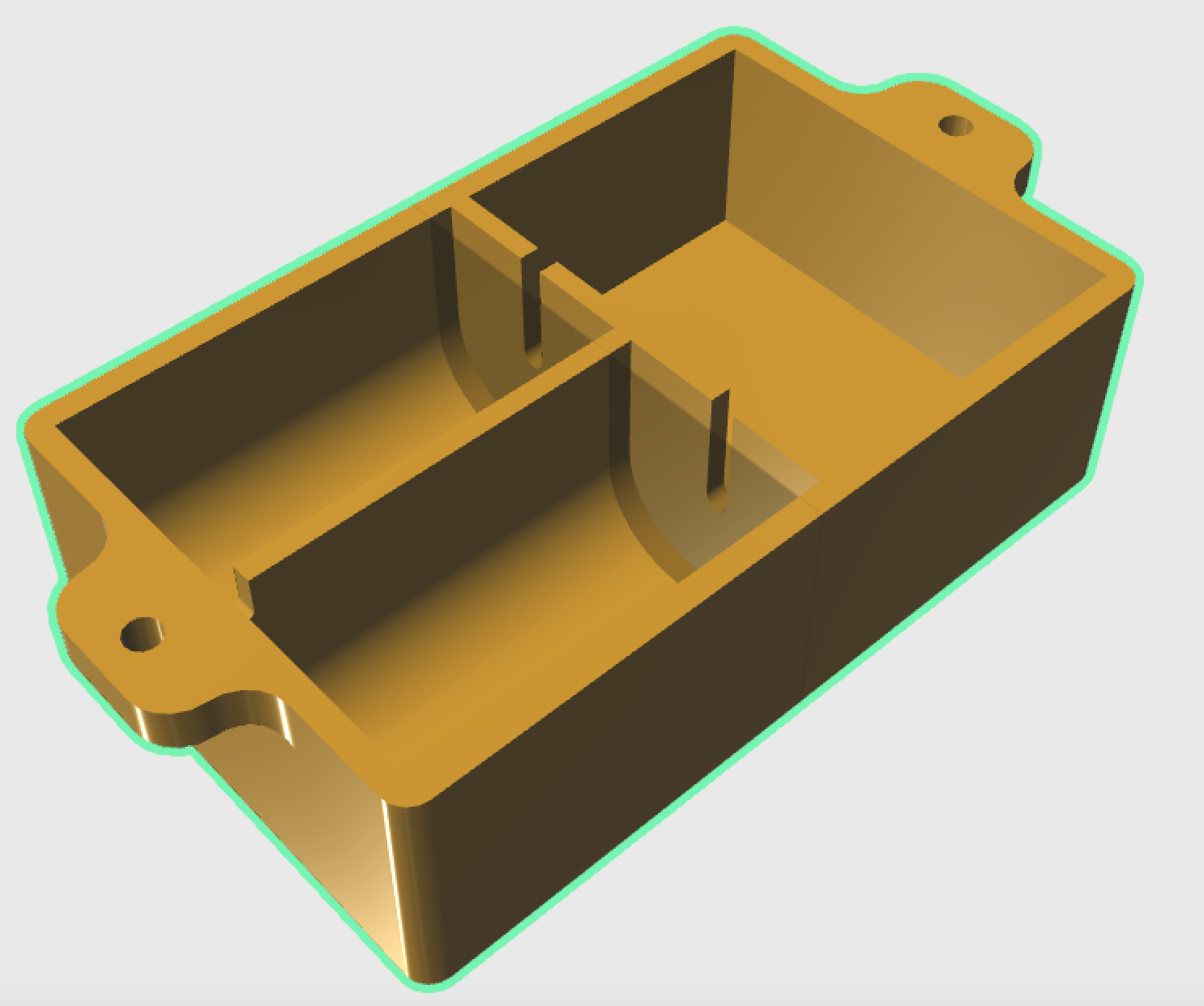
-
@BulldogLowell this looks great once you complete it I will print it. Only problem our raining session is over till Dec. But I can start the build so long :).
-
Nice. But I'm a bit worried about water finding its way into the electronics. Would it be possible to make a cavity for the electronics box in the bottom plate?

@hek
recessing the electronics into the bottom would be tough in this design. I was taking advantage on the two parts to use the smooth plate of the printer, and then make a gasket or even use silicone. lemme think about it. I could add a couple of deflectors on the bottom plate to glue on around where the weep holes are...PS enough room for 2 C sized cells
bottom view:


-
@BulldogLowell Awesome!
I kind of wish I didn't have mine built already :)
I may have missed it but did you have any mounting holes (for the side of a building or pole) What is your vision for that?
It would also be cool to see some place to add a DHT22 in there. On mine I added one of those as well as a BH1750 for light. I'm not sure how long that will hold up though.
-
@BulldogLowell Awesome!
I kind of wish I didn't have mine built already :)
I may have missed it but did you have any mounting holes (for the side of a building or pole) What is your vision for that?
It would also be cool to see some place to add a DHT22 in there. On mine I added one of those as well as a BH1750 for light. I'm not sure how long that will hold up though.
@petewill said:
It would also be cool to see some place to add a DHT22 in there. On mine I added one of those as well as a BH1750 for light. I'm not sure how long that will hold up though.
I'll try to fit that in, if I can, but I'm really focusing on sealing up the electronics. A skirt around the electronics housing may be enough...
I was thinking of a female 'flange-like' option for the unit to sit at the top of some galvanized pipe. It could be mounted that way on the side of a house, a fence or just a pole (back of your basketball backboard!). So, the yellow-brown part will be of two options to print.
-
@petewill said:
It would also be cool to see some place to add a DHT22 in there. On mine I added one of those as well as a BH1750 for light. I'm not sure how long that will hold up though.
I'll try to fit that in, if I can, but I'm really focusing on sealing up the electronics. A skirt around the electronics housing may be enough...
I was thinking of a female 'flange-like' option for the unit to sit at the top of some galvanized pipe. It could be mounted that way on the side of a house, a fence or just a pole (back of your basketball backboard!). So, the yellow-brown part will be of two options to print.
-
@BulldogLowell Awesome!
I kind of wish I didn't have mine built already :)
I may have missed it but did you have any mounting holes (for the side of a building or pole) What is your vision for that?
It would also be cool to see some place to add a DHT22 in there. On mine I added one of those as well as a BH1750 for light. I'm not sure how long that will hold up though.
-
If you add a little edge around the holes, the water cannt flow into the electronic box.
-
As it happens, I am sort of turning the code on its head for this update. Do you want to use accumulated rain over X days as the trigger?
I was thinking about storing the time on EEPROM and retrieving the stored rain values from VERA for each of the last 5 days after a power-up/restart. This saves from having to create too much EEPROM management, plus we can observe how much time has passed in the event of a power-off. That is, if the unit starts up, we test EEPROM to see what was the last day of rain recorded. If it hasn't been more than one, then we retrieve the values from VERA that were previously sent up. Sound OK to you?
I would save an epoch timestamp once each day at midnight when we total today's rain and cascade the values back a day.
-
@BulldogLowell said:
Do you want to use accumulated rain over X days as the trigger?
As opposed to hours? I don't have too strong of an opinion either way. I think whatever is easier works. If they are both the same then maybe hours so we have a little more granular control?
I was thinking about storing the time on EEPROM and retrieving the stored rain values from VERA for each of the last 5 days after a power-up/restart.
I like that it will simplify the EEPROM more and potentially prolong the life of the device (since it's not using as much EEPROM). One thought though, if there is a communication error between Vera and the rain gauge when it is first started is there a way to prevent the rain gauge from subsequently overwriting the values in Vera? I don't know too much about the "ack" portion of the communication but maybe that would make it so it's not an issue?
I'm excited to see the new code. Keep up the good work!
-
@BulldogLowell said:
Do you want to use accumulated rain over X days as the trigger?
As opposed to hours? I don't have too strong of an opinion either way. I think whatever is easier works. If they are both the same then maybe hours so we have a little more granular control?
I was thinking about storing the time on EEPROM and retrieving the stored rain values from VERA for each of the last 5 days after a power-up/restart.
I like that it will simplify the EEPROM more and potentially prolong the life of the device (since it's not using as much EEPROM). One thought though, if there is a communication error between Vera and the rain gauge when it is first started is there a way to prevent the rain gauge from subsequently overwriting the values in Vera? I don't know too much about the "ack" portion of the communication but maybe that would make it so it's not an issue?
I'm excited to see the new code. Keep up the good work!
@petewill said:
As opposed to hours? I don't have too strong of an opinion either way. I think whatever is easier works. If they are both the same then maybe hours so we have a little more granular control?
that's where we were with the 120 hour framework, so let's leave that. I'm not worried about EEPROM life, you get 100,000 writes and that is your lifetime++ using the circular buffer. I did the math on it but can't recall the exact number.
So, we won't change EEPROM data, actually may need to add another 24hours. We just send to VERA the total of each of the past 5 days instead of the total accumulated rainfall over the past 24, 48, 72, 96 and 120 hours. This will be calendar days, we will verify by getting the time from VERA, and synchronize that a few times daily. the days will rollover at midnight, and the daily accumulation will be cascaded back accordingly.
trigger for the sensor will still be total accumulation over so many hours.
Yes?
-
@petewill said:
As opposed to hours? I don't have too strong of an opinion either way. I think whatever is easier works. If they are both the same then maybe hours so we have a little more granular control?
that's where we were with the 120 hour framework, so let's leave that. I'm not worried about EEPROM life, you get 100,000 writes and that is your lifetime++ using the circular buffer. I did the math on it but can't recall the exact number.
So, we won't change EEPROM data, actually may need to add another 24hours. We just send to VERA the total of each of the past 5 days instead of the total accumulated rainfall over the past 24, 48, 72, 96 and 120 hours. This will be calendar days, we will verify by getting the time from VERA, and synchronize that a few times daily. the days will rollover at midnight, and the daily accumulation will be cascaded back accordingly.
trigger for the sensor will still be total accumulation over so many hours.
Yes?
-
@BulldogLowell That sounds GREAT to me! This is your baby though (and you have much more experience with this stuff) so I trust what direction you go.
here is some (untested) mods to update the 5 day rainfall history once per day at midnight. Take a look, let me know what you think (any problems issues). It turns out I was overthinking the problem and it really only needed minor mods...
/* Arduino Tipping Bucket Rain Gauge April 26, 2015 Version 1.4.1 alpha Arduino Tipping Bucket Rain Gauge Utilizing a tipping bucket sensor, your Vera home automation controller and the MySensors.org gateway you can measure and sense local rain. This sketch will create two devices on your Vera controller. One will display your total precipitation for the last 24, 48, 72, 96 and 120 hours. The other, a sensor that changes state if there is recent rain (up to last 120 hours) above a threshold. Both these settings are user definable. This sketch features the following: * Allows you to set the rain threshold in mm * Allows you to determine the interval window up to 120 hours. * Displays the last 5 days of rain in Variable1 through Variable5 of the Rain Sensor device * Configuration changes to Sensor device updated every hour * SHould run on any Arduino * Will retain Tripped/Not Tripped status and data in a power interruption, saving small ammount of data to EEPROM (Circular Buffer to maximize life of EEPROM) * LED status indicator by @BulldogLowell and @PeteWill for free public use */ #include <SPI.h> #include <MySensor.h> #include <math.h> #include <Time.h> #define NODE_ID 24 #define SKETCH_NAME "Rain Gauge" #define SKETCH_VERSION "1.4.1a" #define DWELL_TIME 125 // this allows for radio to come back to power after a transmission, ideally 0 #define DEBUG_ON // comment out this line to disable serial debug #define CHILD_ID_RAIN_LOG 3 // Keeps track of accumulated rainfall #define CHILD_ID_TRIPPED_INDICATOR 4 // Indicates Tripped when rain detected #define EEPROM_STATE_LOCATION 0 // location to save state to EEPROM #define EEPROM_BUFFER_LOCATION 1 // location of the EEPROM circular buffer #define BUFFER_LENGTH 121 #define CALIBRATE_FACTOR 100 // e.g. 5 is .05mm (or 5 hundredths of an inch if imperial) per tip #ifdef DEBUG_ON #define DEBUG_PRINT(x) Serial.print(x) #define DEBUG_PRINTLN(x) Serial.println(x) #define SERIAL_START(x) Serial.begin(x) #else #define DEBUG_PRINT(x) #define DEBUG_PRINTLN(x) #define SERIAL_START(x) #endif // MySensor gw; // MyMessage msgRainRate(CHILD_ID_RAIN_LOG, V_RAINRATE); MyMessage msgRain(CHILD_ID_RAIN_LOG, V_RAIN); // MyMessage msgRainVAR1(CHILD_ID_RAIN_LOG, V_VAR1); MyMessage msgRainVAR2(CHILD_ID_RAIN_LOG, V_VAR2); MyMessage msgRainVAR3(CHILD_ID_RAIN_LOG, V_VAR3); MyMessage msgRainVAR4(CHILD_ID_RAIN_LOG, V_VAR4); MyMessage msgRainVAR5(CHILD_ID_RAIN_LOG, V_VAR5); // MyMessage msgTripped(CHILD_ID_TRIPPED_INDICATOR, V_TRIPPED); MyMessage msgTrippedVar1(CHILD_ID_TRIPPED_INDICATOR, V_VAR1); MyMessage msgTrippedVar2(CHILD_ID_TRIPPED_INDICATOR, V_VAR2); // boolean metric = true; int eepromIndex; int tipSensorPin = 3; // Must be interrupt capable pin int ledPin = 5; // PWM capable pin required unsigned long dataMillis; const unsigned long serialInterval = 10000UL; const unsigned long oneHour = 3600000UL; unsigned long lastTipTime; unsigned long startMillis; unsigned int rainBucket [24] ; /* 24 hours = 1 day of data */ unsigned int rainRate = 0; volatile int wasTippedBuffer = 0; byte rainWindow = 72; //default rain window in hours int rainSensorThreshold = 50; //default rain sensor sensitivity in hundredths. Will be overwritten with msgTrippedVar2. byte state = 0; byte oldState = -1; int lastRainRate = 0; int lastMeasure = 0; boolean gotTime = false; byte lastHour; void setup() { SERIAL_START(115200); // // Set up the IO pinMode(tipSensorPin, INPUT_PULLUP); attachInterrupt (1, sensorTipped, FALLING); // depending on location of the hall effect sensor may need CHANGE pinMode(ledPin, OUTPUT); digitalWrite(ledPin, HIGH); // //Let's get the controller talking to the Arduino gw.begin(getVariables, NODE_ID); gw.sendSketchInfo(SKETCH_NAME, SKETCH_VERSION); delay(DWELL_TIME); gw.present(CHILD_ID_RAIN_LOG, S_RAIN); delay(DWELL_TIME); gw.present(CHILD_ID_TRIPPED_INDICATOR, S_MOTION); delay(DWELL_TIME); DEBUG_PRINTLN(F("Sensor Presentation Complete")); state = gw.loadState(EEPROM_STATE_LOCATION); //retreive prior state from EEPROM DEBUG_PRINT(F("Previous Tripped State (from EEPROM): ")); DEBUG_PRINTLN(state ? "Tripped" : "Not Tripped"); // gw.send(msgTripped.set(state)); delay(DWELL_TIME); // //Sync time with the server, this will be called hourly in order to keep time from creeping with the crystal // while(timeStatus() == timeNotSet) { gw.process(); gw.requestTime(receiveTime); Serial.println("getting Time"); delay(1000); // call once per second Serial.print("."); } // //retrieve from EEPROM stored values on a power cycle. // boolean isDataOnEeprom = false; for (int i = 0; i < BUFFER_LENGTH; i++) { byte locator = gw.loadState(EEPROM_BUFFER_LOCATION + 2 * i); //<<<<<<<<<<< if (locator == 0xFF) // found the EEPROM circular buffer index { eepromIndex = EEPROM_BUFFER_LOCATION + 2 * i; //Now that we have the buffer index let's populate the rainBucket[] with data from eeprom loadRainArray(eepromIndex); isDataOnEeprom = true; DEBUG_PRINT("EEPROM Index "); DEBUG_PRINTLN(eepromIndex); isDataOnEeprom = true; break; } } if (!isDataOnEeprom) // Added for the first time it is run on a new arduino { eepromIndex = 1; gw.saveState(eepromIndex, 0xFF); // store the EEPROM index marker... gw.saveState(eepromIndex + 1, 0xFF); } dataMillis = millis(); startMillis = millis(); lastTipTime = millis() - oneHour; // //Get sensor time window and threshold from controller gw.request(CHILD_ID_TRIPPED_INDICATOR, V_VAR1); delay(DWELL_TIME); gw.request(CHILD_ID_TRIPPED_INDICATOR, V_VAR2); delay(DWELL_TIME); DEBUG_PRINTLN(F("Radio Setup Complete!")); } void loop() { gw.process(); if (state) { prettyFade(); // breathe if tripped } else { slowFlash(); // blink if not tripped } #ifdef DEBUG_ON // Serial Debug Block if ( (millis() - dataMillis) >= serialInterval) { for (int i = 24; i <= 120; i = i + 24) { updateSerialData(i); } dataMillis = millis(); } #endif // // let's constantly check to see if the rain in the past rainWindow hours is greater than rainSensorThreshold // int measure = 0; // Check to see if we need to show sensor tripped in this block for (int i = 0; i < rainWindow; i++) { measure += rainBucket [i]; if (measure != lastMeasure) { DEBUG_PRINT(F("measure value (total rainBucket within rainWindow): ")); DEBUG_PRINTLN(measure); lastMeasure = measure; } } // state = (measure >= rainSensorThreshold); if (state != oldState) { gw.send(msgTripped.set(state)); delay(DWELL_TIME); gw.saveState(EEPROM_STATE_LOCATION, state); //New Code DEBUG_PRINT(F("New Sensor State... Sensor: ")); DEBUG_PRINTLN(state? "Tripped" : "Not Tripped"); oldState = state; } // unsigned long tipDelay = millis() - lastTipTime; if (wasTippedBuffer) // if was tipped, then update the 24hour total and transmit to Vera { DEBUG_PRINTLN(F("Sensor Tipped")); DEBUG_PRINT(F("rainBucket [0] value: ")); DEBUG_PRINTLN(rainBucket [0]); // int dayTotal = 0; for (int i = 0; i < 24; i++) { dayTotal = dayTotal + rainBucket [i]; } // DEBUG_PRINT(F("dayTotal value: ")); DEBUG_PRINTLN(dayTotal); gw.send(msgRain.set(dayTotal, 1)); delay(DWELL_TIME); wasTippedBuffer--; rainRate = ((oneHour) / tipDelay); if (rainRate != lastRainRate) { gw.send(msgRainRate.set(rainRate, 1)); delay(DWELL_TIME); DEBUG_PRINT(F("RainRate= ")); DEBUG_PRINTLN(rainRate); lastRainRate = rainRate; } } if (tipDelay > oneHour) { rainRate = 0; gw.send(msgRainRate.set(rainRate, 1)); } // if (millis() - startMillis >= oneHour) { DEBUG_PRINTLN(F("One hour elapsed.")); for (int i = BUFFER_LENGTH - 1; i >= 0; i--)//cascade an hour of values back into the array { rainBucket [i + 1] = rainBucket [i]; } rainBucket[0] = 0; gw.send(msgRain.set(rainTotal(24), 1)); // send 24hr tips delay(DWELL_TIME); gw.request(CHILD_ID_TRIPPED_INDICATOR, V_VAR1); delay(DWELL_TIME); gw.request(CHILD_ID_TRIPPED_INDICATOR, V_VAR2); delay(DWELL_TIME); gw.saveState(eepromIndex, highByte(rainBucket[0])); gw.saveState(eepromIndex + 1, lowByte(rainBucket[0])); eepromIndex++; if (eepromIndex > EEPROM_BUFFER_LOCATION + BUFFER_LENGTH) eepromIndex = EEPROM_BUFFER_LOCATION; DEBUG_PRINT(F("Writing to EEPROM. Index: ")); DEBUG_PRINTLN(eepromIndex); gw.saveState(eepromIndex, 0xFF); gw.saveState(eepromIndex + 1, 0xFF); gw.requestTime(receiveTime); // sync the time every hour delay(DWELL_TIME); startMillis = millis(); } if (hour() == 0 and lastHour == 23) { transmitRainData(); } lastHour = hour(); } void sensorTipped() { unsigned long thisTipTime = millis(); if (thisTipTime - lastTipTime > 100UL) { rainBucket[0] += CALIBRATE_FACTOR; // adds CALIBRATE_FACTOR hundredths of unit each tip wasTippedBuffer++; } lastTipTime = thisTipTime; } // int rainTotal(int hours) { int total = 0; for ( int i = 0; i < hours; i++) { total += rainBucket [i]; } return total; } void updateSerialData(int x) { DEBUG_PRINT(F("Tips last ")); DEBUG_PRINT(x); DEBUG_PRINTLN(F(" hours: ")); int tipCount = 0; for (int i = 0; i < x; i++) { tipCount = tipCount + rainBucket [i]; } DEBUG_PRINTLN(tipCount); } void loadRainArray(int value) // load stored rain array from EEPROM on powerup { for (int i = 0; i < BUFFER_LENGTH - 1; i++) { value--; DEBUG_PRINT("EEPROM location: "); DEBUG_PRINTLN(value); if (value < EEPROM_BUFFER_LOCATION) { value = EEPROM_BUFFER_LOCATION + BUFFER_LENGTH; } byte rainValueHigh = gw.loadState(value); byte rainValueLow = gw.loadState(value + 1); int rainValue = (rainValueHigh << 8) & rainValueLow; rainBucket[i] = rainValue; // DEBUG_PRINT(F("rainBucket[ value: ")); DEBUG_PRINT(i); DEBUG_PRINT(F("] value: ")); DEBUG_PRINTLN(rainBucket[i]); } } void transmitRainData(void) { int rainUpdateTotal = 0; for (int i = 0; i < 24; i++) { rainUpdateTotal += rainBucket[i]; } gw.send(msgRainVAR1.set(( float) rainUpdateTotal / 100.0 , 1)); delay(DWELL_TIME); rainUpdateTotal = 0; for (int i = 24; i < 48; i++) { rainUpdateTotal += rainBucket[i]; } gw.send(msgRainVAR2.set( (float) rainUpdateTotal / 100.0 , 1)); delay(DWELL_TIME); rainUpdateTotal = 0; for (int i = 48; i < 72; i++) { rainUpdateTotal += rainBucket[i]; } gw.send(msgRainVAR3.set( (float) rainUpdateTotal / 100.0 , 1)); delay(DWELL_TIME); rainUpdateTotal = 0; for (int i = 72; i < 96; i++) { rainUpdateTotal += rainBucket[i]; } gw.send(msgRainVAR4.set( (float) rainUpdateTotal / 100.0 , 1)); delay(DWELL_TIME); rainUpdateTotal = 0; for (int i = 96; i < 120; i++) { rainUpdateTotal += rainBucket[i]; } gw.send(msgRainVAR5.set( (float) rainUpdateTotal / 100.0 , 1)); delay(DWELL_TIME); } void getVariables(const MyMessage &message) { if (message.sensor == CHILD_ID_RAIN_LOG) { // nothing to do here } else if (message.sensor == CHILD_ID_TRIPPED_INDICATOR) { if (message.type == V_VAR1) { rainWindow = atoi(message.data); if (rainWindow > 120) { rainWindow = 120; } else if (rainWindow < 1) { rainWindow = 1; } if (rainWindow != atoi(message.data)) // if I changed the value back inside the boundries, push that number back to Vera { gw.send(msgTrippedVar1.set(rainWindow)); } } else if (message.type == V_VAR2) { rainSensorThreshold = atoi(message.data); if (rainSensorThreshold > 10000) { rainSensorThreshold = 10000; } else if (rainSensorThreshold < 1) { rainSensorThreshold = 1; } if (rainSensorThreshold != atoi(message.data)) // if I changed the value back inside the boundries, push that number back to Vera { gw.send(msgTrippedVar2.set(rainSensorThreshold)); } } } } void prettyFade(void) { float val = (exp(sin(millis() / 2000.0 * PI)) - 0.36787944) * 108.0; analogWrite(ledPin, val); } void slowFlash(void) { static boolean ledState = true; static unsigned long pulseStart = millis(); if (millis() - pulseStart < 100UL) { digitalWrite(ledPin, !ledState); pulseStart = millis(); } } void receiveTime(unsigned long time) { DEBUG_PRINTLN(F("Time received from controller...")); setTime(time); char theTime[26]; sprintf(theTime, "The current time is %d:%2d", hour(), minute()); DEBUG_PRINTLN(theTime); } -
here is some (untested) mods to update the 5 day rainfall history once per day at midnight. Take a look, let me know what you think (any problems issues). It turns out I was overthinking the problem and it really only needed minor mods...
/* Arduino Tipping Bucket Rain Gauge April 26, 2015 Version 1.4.1 alpha Arduino Tipping Bucket Rain Gauge Utilizing a tipping bucket sensor, your Vera home automation controller and the MySensors.org gateway you can measure and sense local rain. This sketch will create two devices on your Vera controller. One will display your total precipitation for the last 24, 48, 72, 96 and 120 hours. The other, a sensor that changes state if there is recent rain (up to last 120 hours) above a threshold. Both these settings are user definable. This sketch features the following: * Allows you to set the rain threshold in mm * Allows you to determine the interval window up to 120 hours. * Displays the last 5 days of rain in Variable1 through Variable5 of the Rain Sensor device * Configuration changes to Sensor device updated every hour * SHould run on any Arduino * Will retain Tripped/Not Tripped status and data in a power interruption, saving small ammount of data to EEPROM (Circular Buffer to maximize life of EEPROM) * LED status indicator by @BulldogLowell and @PeteWill for free public use */ #include <SPI.h> #include <MySensor.h> #include <math.h> #include <Time.h> #define NODE_ID 24 #define SKETCH_NAME "Rain Gauge" #define SKETCH_VERSION "1.4.1a" #define DWELL_TIME 125 // this allows for radio to come back to power after a transmission, ideally 0 #define DEBUG_ON // comment out this line to disable serial debug #define CHILD_ID_RAIN_LOG 3 // Keeps track of accumulated rainfall #define CHILD_ID_TRIPPED_INDICATOR 4 // Indicates Tripped when rain detected #define EEPROM_STATE_LOCATION 0 // location to save state to EEPROM #define EEPROM_BUFFER_LOCATION 1 // location of the EEPROM circular buffer #define BUFFER_LENGTH 121 #define CALIBRATE_FACTOR 100 // e.g. 5 is .05mm (or 5 hundredths of an inch if imperial) per tip #ifdef DEBUG_ON #define DEBUG_PRINT(x) Serial.print(x) #define DEBUG_PRINTLN(x) Serial.println(x) #define SERIAL_START(x) Serial.begin(x) #else #define DEBUG_PRINT(x) #define DEBUG_PRINTLN(x) #define SERIAL_START(x) #endif // MySensor gw; // MyMessage msgRainRate(CHILD_ID_RAIN_LOG, V_RAINRATE); MyMessage msgRain(CHILD_ID_RAIN_LOG, V_RAIN); // MyMessage msgRainVAR1(CHILD_ID_RAIN_LOG, V_VAR1); MyMessage msgRainVAR2(CHILD_ID_RAIN_LOG, V_VAR2); MyMessage msgRainVAR3(CHILD_ID_RAIN_LOG, V_VAR3); MyMessage msgRainVAR4(CHILD_ID_RAIN_LOG, V_VAR4); MyMessage msgRainVAR5(CHILD_ID_RAIN_LOG, V_VAR5); // MyMessage msgTripped(CHILD_ID_TRIPPED_INDICATOR, V_TRIPPED); MyMessage msgTrippedVar1(CHILD_ID_TRIPPED_INDICATOR, V_VAR1); MyMessage msgTrippedVar2(CHILD_ID_TRIPPED_INDICATOR, V_VAR2); // boolean metric = true; int eepromIndex; int tipSensorPin = 3; // Must be interrupt capable pin int ledPin = 5; // PWM capable pin required unsigned long dataMillis; const unsigned long serialInterval = 10000UL; const unsigned long oneHour = 3600000UL; unsigned long lastTipTime; unsigned long startMillis; unsigned int rainBucket [24] ; /* 24 hours = 1 day of data */ unsigned int rainRate = 0; volatile int wasTippedBuffer = 0; byte rainWindow = 72; //default rain window in hours int rainSensorThreshold = 50; //default rain sensor sensitivity in hundredths. Will be overwritten with msgTrippedVar2. byte state = 0; byte oldState = -1; int lastRainRate = 0; int lastMeasure = 0; boolean gotTime = false; byte lastHour; void setup() { SERIAL_START(115200); // // Set up the IO pinMode(tipSensorPin, INPUT_PULLUP); attachInterrupt (1, sensorTipped, FALLING); // depending on location of the hall effect sensor may need CHANGE pinMode(ledPin, OUTPUT); digitalWrite(ledPin, HIGH); // //Let's get the controller talking to the Arduino gw.begin(getVariables, NODE_ID); gw.sendSketchInfo(SKETCH_NAME, SKETCH_VERSION); delay(DWELL_TIME); gw.present(CHILD_ID_RAIN_LOG, S_RAIN); delay(DWELL_TIME); gw.present(CHILD_ID_TRIPPED_INDICATOR, S_MOTION); delay(DWELL_TIME); DEBUG_PRINTLN(F("Sensor Presentation Complete")); state = gw.loadState(EEPROM_STATE_LOCATION); //retreive prior state from EEPROM DEBUG_PRINT(F("Previous Tripped State (from EEPROM): ")); DEBUG_PRINTLN(state ? "Tripped" : "Not Tripped"); // gw.send(msgTripped.set(state)); delay(DWELL_TIME); // //Sync time with the server, this will be called hourly in order to keep time from creeping with the crystal // while(timeStatus() == timeNotSet) { gw.process(); gw.requestTime(receiveTime); Serial.println("getting Time"); delay(1000); // call once per second Serial.print("."); } // //retrieve from EEPROM stored values on a power cycle. // boolean isDataOnEeprom = false; for (int i = 0; i < BUFFER_LENGTH; i++) { byte locator = gw.loadState(EEPROM_BUFFER_LOCATION + 2 * i); //<<<<<<<<<<< if (locator == 0xFF) // found the EEPROM circular buffer index { eepromIndex = EEPROM_BUFFER_LOCATION + 2 * i; //Now that we have the buffer index let's populate the rainBucket[] with data from eeprom loadRainArray(eepromIndex); isDataOnEeprom = true; DEBUG_PRINT("EEPROM Index "); DEBUG_PRINTLN(eepromIndex); isDataOnEeprom = true; break; } } if (!isDataOnEeprom) // Added for the first time it is run on a new arduino { eepromIndex = 1; gw.saveState(eepromIndex, 0xFF); // store the EEPROM index marker... gw.saveState(eepromIndex + 1, 0xFF); } dataMillis = millis(); startMillis = millis(); lastTipTime = millis() - oneHour; // //Get sensor time window and threshold from controller gw.request(CHILD_ID_TRIPPED_INDICATOR, V_VAR1); delay(DWELL_TIME); gw.request(CHILD_ID_TRIPPED_INDICATOR, V_VAR2); delay(DWELL_TIME); DEBUG_PRINTLN(F("Radio Setup Complete!")); } void loop() { gw.process(); if (state) { prettyFade(); // breathe if tripped } else { slowFlash(); // blink if not tripped } #ifdef DEBUG_ON // Serial Debug Block if ( (millis() - dataMillis) >= serialInterval) { for (int i = 24; i <= 120; i = i + 24) { updateSerialData(i); } dataMillis = millis(); } #endif // // let's constantly check to see if the rain in the past rainWindow hours is greater than rainSensorThreshold // int measure = 0; // Check to see if we need to show sensor tripped in this block for (int i = 0; i < rainWindow; i++) { measure += rainBucket [i]; if (measure != lastMeasure) { DEBUG_PRINT(F("measure value (total rainBucket within rainWindow): ")); DEBUG_PRINTLN(measure); lastMeasure = measure; } } // state = (measure >= rainSensorThreshold); if (state != oldState) { gw.send(msgTripped.set(state)); delay(DWELL_TIME); gw.saveState(EEPROM_STATE_LOCATION, state); //New Code DEBUG_PRINT(F("New Sensor State... Sensor: ")); DEBUG_PRINTLN(state? "Tripped" : "Not Tripped"); oldState = state; } // unsigned long tipDelay = millis() - lastTipTime; if (wasTippedBuffer) // if was tipped, then update the 24hour total and transmit to Vera { DEBUG_PRINTLN(F("Sensor Tipped")); DEBUG_PRINT(F("rainBucket [0] value: ")); DEBUG_PRINTLN(rainBucket [0]); // int dayTotal = 0; for (int i = 0; i < 24; i++) { dayTotal = dayTotal + rainBucket [i]; } // DEBUG_PRINT(F("dayTotal value: ")); DEBUG_PRINTLN(dayTotal); gw.send(msgRain.set(dayTotal, 1)); delay(DWELL_TIME); wasTippedBuffer--; rainRate = ((oneHour) / tipDelay); if (rainRate != lastRainRate) { gw.send(msgRainRate.set(rainRate, 1)); delay(DWELL_TIME); DEBUG_PRINT(F("RainRate= ")); DEBUG_PRINTLN(rainRate); lastRainRate = rainRate; } } if (tipDelay > oneHour) { rainRate = 0; gw.send(msgRainRate.set(rainRate, 1)); } // if (millis() - startMillis >= oneHour) { DEBUG_PRINTLN(F("One hour elapsed.")); for (int i = BUFFER_LENGTH - 1; i >= 0; i--)//cascade an hour of values back into the array { rainBucket [i + 1] = rainBucket [i]; } rainBucket[0] = 0; gw.send(msgRain.set(rainTotal(24), 1)); // send 24hr tips delay(DWELL_TIME); gw.request(CHILD_ID_TRIPPED_INDICATOR, V_VAR1); delay(DWELL_TIME); gw.request(CHILD_ID_TRIPPED_INDICATOR, V_VAR2); delay(DWELL_TIME); gw.saveState(eepromIndex, highByte(rainBucket[0])); gw.saveState(eepromIndex + 1, lowByte(rainBucket[0])); eepromIndex++; if (eepromIndex > EEPROM_BUFFER_LOCATION + BUFFER_LENGTH) eepromIndex = EEPROM_BUFFER_LOCATION; DEBUG_PRINT(F("Writing to EEPROM. Index: ")); DEBUG_PRINTLN(eepromIndex); gw.saveState(eepromIndex, 0xFF); gw.saveState(eepromIndex + 1, 0xFF); gw.requestTime(receiveTime); // sync the time every hour delay(DWELL_TIME); startMillis = millis(); } if (hour() == 0 and lastHour == 23) { transmitRainData(); } lastHour = hour(); } void sensorTipped() { unsigned long thisTipTime = millis(); if (thisTipTime - lastTipTime > 100UL) { rainBucket[0] += CALIBRATE_FACTOR; // adds CALIBRATE_FACTOR hundredths of unit each tip wasTippedBuffer++; } lastTipTime = thisTipTime; } // int rainTotal(int hours) { int total = 0; for ( int i = 0; i < hours; i++) { total += rainBucket [i]; } return total; } void updateSerialData(int x) { DEBUG_PRINT(F("Tips last ")); DEBUG_PRINT(x); DEBUG_PRINTLN(F(" hours: ")); int tipCount = 0; for (int i = 0; i < x; i++) { tipCount = tipCount + rainBucket [i]; } DEBUG_PRINTLN(tipCount); } void loadRainArray(int value) // load stored rain array from EEPROM on powerup { for (int i = 0; i < BUFFER_LENGTH - 1; i++) { value--; DEBUG_PRINT("EEPROM location: "); DEBUG_PRINTLN(value); if (value < EEPROM_BUFFER_LOCATION) { value = EEPROM_BUFFER_LOCATION + BUFFER_LENGTH; } byte rainValueHigh = gw.loadState(value); byte rainValueLow = gw.loadState(value + 1); int rainValue = (rainValueHigh << 8) & rainValueLow; rainBucket[i] = rainValue; // DEBUG_PRINT(F("rainBucket[ value: ")); DEBUG_PRINT(i); DEBUG_PRINT(F("] value: ")); DEBUG_PRINTLN(rainBucket[i]); } } void transmitRainData(void) { int rainUpdateTotal = 0; for (int i = 0; i < 24; i++) { rainUpdateTotal += rainBucket[i]; } gw.send(msgRainVAR1.set(( float) rainUpdateTotal / 100.0 , 1)); delay(DWELL_TIME); rainUpdateTotal = 0; for (int i = 24; i < 48; i++) { rainUpdateTotal += rainBucket[i]; } gw.send(msgRainVAR2.set( (float) rainUpdateTotal / 100.0 , 1)); delay(DWELL_TIME); rainUpdateTotal = 0; for (int i = 48; i < 72; i++) { rainUpdateTotal += rainBucket[i]; } gw.send(msgRainVAR3.set( (float) rainUpdateTotal / 100.0 , 1)); delay(DWELL_TIME); rainUpdateTotal = 0; for (int i = 72; i < 96; i++) { rainUpdateTotal += rainBucket[i]; } gw.send(msgRainVAR4.set( (float) rainUpdateTotal / 100.0 , 1)); delay(DWELL_TIME); rainUpdateTotal = 0; for (int i = 96; i < 120; i++) { rainUpdateTotal += rainBucket[i]; } gw.send(msgRainVAR5.set( (float) rainUpdateTotal / 100.0 , 1)); delay(DWELL_TIME); } void getVariables(const MyMessage &message) { if (message.sensor == CHILD_ID_RAIN_LOG) { // nothing to do here } else if (message.sensor == CHILD_ID_TRIPPED_INDICATOR) { if (message.type == V_VAR1) { rainWindow = atoi(message.data); if (rainWindow > 120) { rainWindow = 120; } else if (rainWindow < 1) { rainWindow = 1; } if (rainWindow != atoi(message.data)) // if I changed the value back inside the boundries, push that number back to Vera { gw.send(msgTrippedVar1.set(rainWindow)); } } else if (message.type == V_VAR2) { rainSensorThreshold = atoi(message.data); if (rainSensorThreshold > 10000) { rainSensorThreshold = 10000; } else if (rainSensorThreshold < 1) { rainSensorThreshold = 1; } if (rainSensorThreshold != atoi(message.data)) // if I changed the value back inside the boundries, push that number back to Vera { gw.send(msgTrippedVar2.set(rainSensorThreshold)); } } } } void prettyFade(void) { float val = (exp(sin(millis() / 2000.0 * PI)) - 0.36787944) * 108.0; analogWrite(ledPin, val); } void slowFlash(void) { static boolean ledState = true; static unsigned long pulseStart = millis(); if (millis() - pulseStart < 100UL) { digitalWrite(ledPin, !ledState); pulseStart = millis(); } } void receiveTime(unsigned long time) { DEBUG_PRINTLN(F("Time received from controller...")); setTime(time); char theTime[26]; sprintf(theTime, "The current time is %d:%2d", hour(), minute()); DEBUG_PRINTLN(theTime); }Wow, just wow man.... that is a thing of beauty!!

